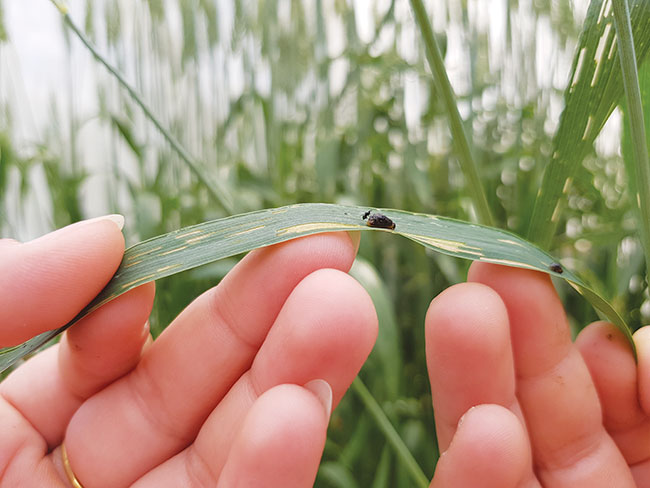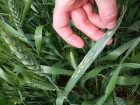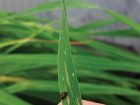
Features
Insect Pests
Economic thresholds for cereal leaf beetle
Natural predators and Prairie conditions seem to be keeping cereal leaf beetle levels below yield damaging thresholds.
April 29, 2020 By Donna Fleury
 The tiny adult parasitoid wasp T. julis laying its eggs inside a cereal leaf beetle larvae, which has already caused feeding damage. This is a beneficial insect in action. Note how small it is, which makes it almost impossible for an untrained eye to notice this valuable insect in their field.
Photo courtesy of Emily Lemke.
The tiny adult parasitoid wasp T. julis laying its eggs inside a cereal leaf beetle larvae, which has already caused feeding damage. This is a beneficial insect in action. Note how small it is, which makes it almost impossible for an untrained eye to notice this valuable insect in their field.
Photo courtesy of Emily Lemke. Cereal leaf beetle first appeared on the Canadian Prairies in 2005, and researchers have been closely monitoring the pest ever since. Although it is an invasive pest in Europe and has been in Eastern Canada and the southern United States since the 1960s, no western Canadian economic thresholds were available. And it’s not economic to apply chemicals to insects if they are not doing a lot of damage.
“Without more local data for the Canadian Prairies, we had to look to economic thresholds from the southern U.S. for larval feeding levels that cause defoliation and yield loss,” explains Haley Catton, research scientist with Agriculture and Agri-Food Canada in Lethbridge, Alta. “The economic threshold in wheat for the U.S. is 0.4 to 1 larvae per flag leaf, which would be one larvae on four of every 10 flag leaves in the crop. We wanted to develop an economic threshold relevant to western Canadian crops and conditions,” Catton says.
“We also know that natural enemies are important for control of cereal leaf beetle, so understanding the impact of the biocontrol wasp Tetrastichus julis and other generalist predators (such as spiders, lady beetles, carabids and nabid bugs) that eat eggs and larvae in Western Canada was an important component. There are a lot of factors going on and we needed more knowledge to make decisions to make sure we balance controlling the pest while protecting the natural predators and their control benefits.”
In 2016, Catton initiated a three-year project to quantify the effects of cereal leaf beetle and its natural enemies on western Canadian spring wheat. Catton notes that the project was building on the important work her colleague Héctor Cárcamo and his team had previously completed around cereal leaf beetle and the biocontrol wasp T. julis.
This larval parasitoid, which has been widely relocated across the Canadian Prairies since 2009, is a specialist to cereal leaf beetle larvae and has shown high parasitism rates. T. julis is a very tiny wasp, about two millimetres long in adult form, that lays its eggs inside cereal leaf beetle larvae, helping control the pest.
For this project, cage studies were conducted on dryland spring wheat near Lethbridge over three years. The trials focused on three key factors and included seven treatments: comparing the presence or absence of cereal leaf beetle, generalist predators, and T. julis, in cages with cereal leaf beetle, as well as an uncaged control. Throughout the growing season, cereal leaf beetle larval numbers, flag leaf damage and aphid infestation in the cages were monitored. At harvest, crop yield and total insects recovered in the cages were measured.
“Overall, despite our best efforts, we could not get a cereal leaf beetle effect on yield impact on wheat,” Catton says. “In 2017 and 2018, we actually added 44 adult cereal leaf beetles to the one-metre square cages, which visually looks like a lot of beetles. Even at these very high densities of adult beetles, there were few larvae and no yield impact to the wheat crop at all. The cereal leaf beetle larvae at the levels observed did not have a significant effect on yield in any year,” she says.
“Aphids tended to be more of a problem inside the cages, and we are trying to determine if they interact with cereal leaf beetle on yield impacts. The results of the study confirm that, to date, the economic threshold for cereal leaf beetle on the Canadian Prairies is at least one larva per flag leaf, because at levels lower than this we saw no yield impact,” she adds, noting that in discussion with producers, it seems the insect rarely reaches levels this high in Western Canada.
“Therefore, chemical control of cereal leaf beetle is not necessary at the levels observed and could harm beneficial insects. We also were unable to detect the impacts of T. julis and generalist predators in this study, because pest pressure was low, but we think T. julis is a big reason why cereal leaf beetle has not become a major pest on the Prairies.”
Cárcamo began distributing the T. julis wasp to cereal leaf beetle infestations across the Prairies in 2009. Researchers suspect the combination of the parasitoid wasp and western Canadian growing conditions are providing cereal leaf beetle larvae control. In recent years, Catton has been conducting a survey on cereal leaf beetle larvae to monitor the spread and impact of the biocontrol wasp.
“The problem with documenting a success story like this, is we are still having a challenge trying to collect enough cereal leaf beetle larvae to be able to dissect and determine parasitoid levels,” she adds.
“We are continuing to try to monitor and collect cereal leaf beetle larvae from across the Prairies to try to determine how far this biocontrol wasp T. julis has spread and at what rate it is spreading. When we do get cereal leaf beetle larvae samples, it is common for us to find more than 50 per cent of larvae in a field are parasitized, which means they will die.”
Catton and her team are asking growers to collect and send cereal leaf beetle larvae samples. “This will help us better understand the parasitoid, and we will also provide information back to growers about the levels in their fields. If we don’t find any parasitoids, we may be able to provide T. julis to growers for their fields to help increase their population.” If you have samples, contact Catton via email: haley.catton@canada.ca or by phone: 403-317-3404.
The economic threshold project is now completed, but Catton is working on a new project focused on T. julis. The project is being conducted in greenhouse experiments to better understand the relationship and impacts of the pest and the parasitoid.
The most important message from the study, Catton emphasizes, is that, in most cases, cereal leaf beetle is not causing economic damage to crops at the levels found in fields, so chemical spraying is not needed.
“Unnecessary spraying also kills the beneficials that are silently providing value that is often overlooked. We sometimes call T. julis and the other natural predators the ‘unpaid army’. The contribution of the natural predators is actually worth a lot of money, and may have turned the cereal leaf beetle pest into mostly a non-issue for growers so far. Don’t spray unless absolutely necessary to protect the natural predators that are adding value and pest control in fields.”


